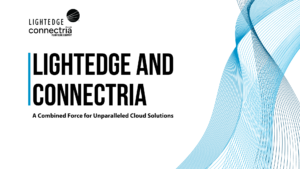Organizations have now been leveraging hybrid cloud strategies for a few years, and many leadership teams tout the cost-effectiveness, flexibility, scalability and security they experienced after adoption.
Adoption of the hybrid model varies widely across industries, but according to a recent study by TECHnalysis, of the 600 medium and large U.S.-based organizations, only 29% are leveraging a hybrid cloud environment. The number of hybrid cloud migrations is expected to increase over the coming years.
Many organizations who were quick to jump to the public cloud are now realizing that they crave more resilient networks, support for legacy applications and overall, better cost containment. Hybrid cloud can help organizations solve for all these issues and effectively help organizations maximize their investment toward core business.
Hybrid cloud environments, at their simplest definition, occur when an organization leverages two or more cloud environments for their IT infrastructure. While this technically could mean that a hybrid environment is two public or two private clouds, one of the most common configurations is a combination of public and private cloud infrastructure as both options have their pros and cons.
Why Hybrid Matters
You know by now that each organization has its unique workload that their IT environment needs to support. Whether you’re running legacy applications, are concerned about security or cost, there is a hybrid cloud arrangement that can work for your organization. For example, if you’re currently satisfied with your private cloud environment and its security and flexibility, you may be tempted to keep everything in the private cloud, but the public cloud can be better suited for certain workloads such as large, globally-distributed environments, making your organization’s operations (and possibly spending) less efficient.
A hybrid environment is an excellent option to get the best of both worlds. The same is true if your organization requires certain workloads or components of your infrastructure to be more secure than others, for compliance reasons or simply because you’ve been burned by an attack attempt before.
When considering the risks and benefits of public cloud, it can be easy to dismiss the public cloud as the lesser option. It’s important to note that the public cloud is not the villain here and still serves a critical role in truly effective hybrid environments. When appropriately leveraged it has the potential to revolutionize the way you manage your IT.
Why Public Cloud
Public cloud is a multi-tenant environment which can, in a few cases, lower the capital spend that organizations experience. It tends to be the most accessible through public cloud providers and is the gateway to cloud for many businesses. That being said, beware of extra costs beyond the price in the initial agreement.
There are a set of risks that organizations should be aware of when considering a public cloud environment. One of the biggest concerns is security. Given the multi-tenant nature of the public cloud, cyberattacks or potential data breaches have more surface area to attack from the outside. It’s not unheard of to have “leaky” attacks that spread from one organization’s environment to another.
Which Data Should I Store in Public Environments?
While there are some security risks with the public cloud, there are a number of specific use cases that drive businesses to adopt this strategy. A few of the most common reasons organizations move to the public cloud include:
- The desire to support serverless computing like purchase tracking or chatbots.
- Large globally distributed development environments
- Wanting to reap the full benefits of IoT networks and require CDN connectivity to endpoint devices.
Why Private Cloud
If you’re looking for maximum control over your environments, especially those running legacy applications, private cloud may be exactly what you’re looking for. Private cloud is just what it sounds like: single-tenant occupancy. Private cloud has long been considered the premium option for those seeking cloud environments and many expect it to come with a price tag to match. However, in reality, private cloud providers provide transparent, more inclusive billing within their contracts and often have additional services available at no extra cost to the customer such as support and security features. The security features and available compliance certifications (some with inheritable scores) can make private cloud an attractive option for organizations looking for a premium boost into the cloud without breaking the bank.
Some of the risks associated with private cloud can include vendor lock-in, where it’s more expensive to leave a cloud provider than it is to stay. This can be prevented by assessing whether or not there will be egress costs with re-writing the language of whatever cloud provider you choose. Being sure your cloud environment or environments are compatible with any other IT infrastructure is critical to effectively leveraging a hybrid environment.
Which Data Should I store in Private Environments?
Private cloud environments are great for mission-critical infrastructure that you need complete control over and need to be kept optimally secure. If your organization implemented a data classification policy, this can be a good guide for what needs to stay locked down in a private environment.
In addition to security, many organizations opt for a private environment for the opportunities it provides when it comes to performance improvement, application modernization and cost effectiveness. At the end of the day, private cloud gives you more control than public cloud ever can and you have the ability to customize your environment both now and as your needs change.
It’s also important to consider whether you need on-ramps to the public cloud when planning a private environment. If you ever plan to migrate to a hybrid cloud model, this is a discussion to have with your provider now rather than later.
Is a Hybrid Migration in Your Future?
After reading the points above, a move to hybrid cloud requires organizations to weigh a multitude of factors, many of which are unique to each organization. There are also key considerations that make a hybrid solution necessary to any IT team, if they know the direction their organization is heading over the next few years. These considerations can make or break your hybrid migration:
- Next generation cloud applications
- Support for legacy workloads
- Auditing and compliance concerns
- Data sovereignty
- Network latency
- A refocus of internal IT staff on key business initiatives
- On perm capex concerns or aging hardware
How to Evaluate a Hybrid Cloud Partner
Everything starts and ends with people who have the expertise in networking, compute infrastructure, and security and compliance. Partners must not only provide industry recognized tools, but need to be able to answer questions and assist the customer in designing and maintaining their hybrid cloud infrastructure as their needs evolve over time.
Gauging their ability to recognize where workloads should live and provide guidance and to bridge public and private cloud infrastructure can save you time, expense and headaches in the future, especially when discussing compatibility and legacy application support.
LightEdge Empowers Enterprises to Find Their Best Cloud Environments
At LightEdge, we take our role as a leader in the IT space seriously and have maintained it for over a quarter of a century. We’ve helped hundreds of organizations work through their cloud woes and come out with the best possible cloud configuration for their business objectives. We’ve empowered customers to thrive in the cloud and helped them do away with the ambiguity that can come by taking on cloud environments alone.
Whether you’re looking for a dedicated private environment or on-ramps to the public cloud, LightEdge’s team of experts is ready to answer your most pressing questions and get your new environment deployed quickly and securely. If you’re looking to better allocate your IT resources, avoid vendor lock-in and partner with industry experts, set up a time to chat with us about the future of your IT strategy.




